Intervals are the spaces between notes that shape melodies and harmonies, having the power to enhance your music with emotional power and structural complexity.
They determine how sounds combine and clash 一 contributing to the foundational aspects of music theory as well as sound design and overall composition.
Understanding intervals can help you create more engaging and dynamic tracks.
So, as a music producer, it’s important to understand what are intervals in music so you can manipulate these elements in super creative ways.
In today’s article, we’ll break down:
- What are intervals in music ✓
- Basic interval types (like a perfect or minor interval) ✓
- Melodic intervals and harmonic intervals ✓
- Interval qualities, simple intervals & complex intervals ✓
- Major intervals and minor intervals ✓
- Compound intervals and other intervals ✓
- Dissonant intervals vs consonant intervals ✓
- Techniques for creating harmonies ✓
- Enhancing melodies with intervals ✓
- Interval identification techniques ✓
- Music theory essentials like major or minor interval ✓
- Much more about what are intervals in music ✓
By the end of this article, you’ll have a solid understanding of what are intervals in music so you can create and manipulate music like a pro.
Whether you are laying down a new track, arranging, or simply tweaking a melody, the insights provided here will be invaluable.
So, let’s dive in…
Table of Contents
What Are Intervals in Music? Breaking it Down

Intervals are the pitch distance between two notes, and understanding them can help you dictate the harmonic and melodic structure of your tracks.
A musical interval might be:
- As small as a minor second (like the notes C to C#) creating a dissonant sound.
- As large as a perfect octave (like C to the next higher C) which feels complete.
For example, the power of the perfect fifth, often called the ‘power chord’ in rock music is notorious for its strong, stabilizing sound, which we’ll break down later.
It’s one of the most popular in genres that thrive on epic sonic presence.
Knowing how different intervals can evoke certain feelings will not only enhance your skills, but help you create music with layers of emotions.
It will reel your listeners in and keep them wanting more (which is super beneficial).
-
Importance of Intervals in Music Production
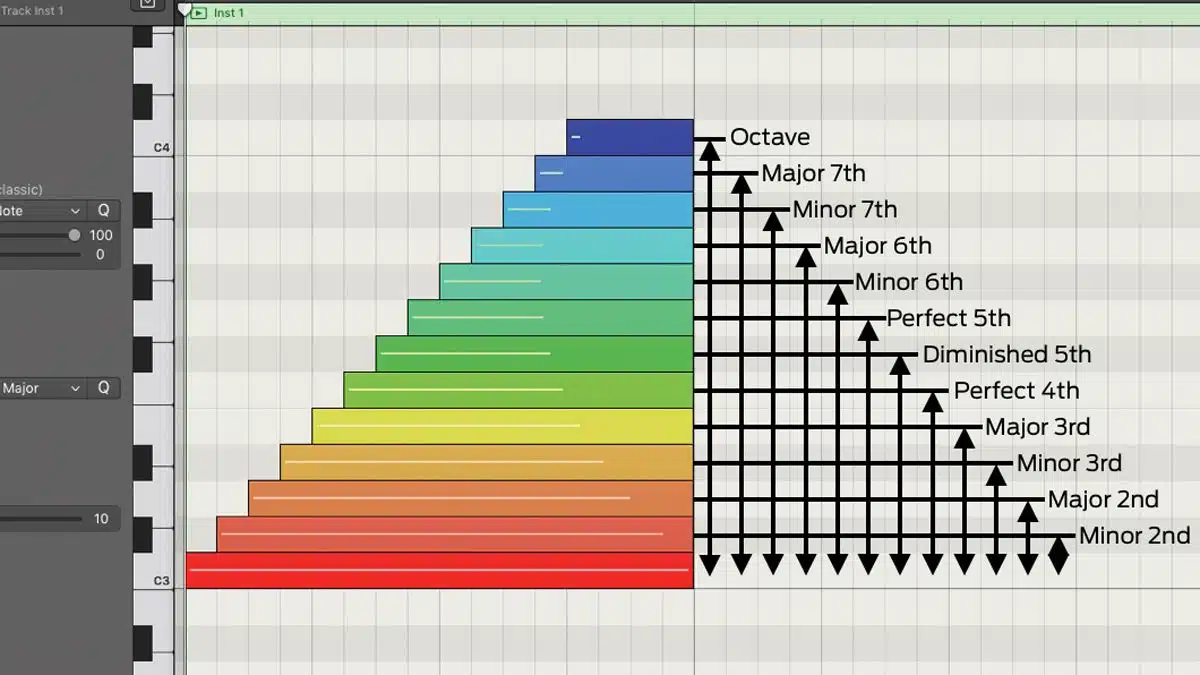
Intervals are key parts of music production, sound design, and audio engineering.
The minor third, for instance, which spans three semitones (like E to G), can offer a more melancholic tint to your melodies; essential to R&B, blues, and jazz.
On the flip side, the major third (like C to E) provides a brighter, more uplifting quality 一 ideal for creating happier, pop-style melodies.
This understanding influences everything from tuning synthesizers to layering harmonies, and most things in between.
For example, in EDM, precise interval choices can completely change the entire vibe of a track, turning a simple loop into an immersive journey.
So, if you’re trying to create tracks that not only captivate, but innovate, then learning what are intervals in music can fast-track this process.
Understanding Basic Interval Types
Now that you have a basic understanding of what are intervals in music, let’s break it down another notch. You’re going to categorize them primarily into melodic and harmonic types, each playing a distinct role that you’ll need to know. Understanding the following intervals are the first step…
-
Melodic Intervals

Melodic intervals refer to the sequence of notes played one after the other; super important for laying down melodies
A simple example is the major second, like C to D, which provides a sense of forward motion in a melody.
It’s commonly used in walking basslines or in the ascending opening of a pop vocal line.
You can use a melodic interval to, let’s say, create a lead synth line in EDM…
The intervallic relationship between successive notes determine the energy and tempo of a melody to get people running to the dancefloor.
NOTE: Using a series of ascending minor thirds can create a haunting, mysterious atmosphere, which is super compelling in darker forms of electronic music.
-
Harmonic Intervals

Harmonic intervals occur when two notes are played simultaneously and are foundational in chord construction.
Let’s take a C major chord, for example, which includes the following intervals:
- A major third (C to E)
- A perfect fifth (C to G)
This stable, consonant combination forms the basis of much Western music 一 providing a pleasing and clear sound ideal for basically any genre you can think of.
In production, understanding how to stack a harmonic interval within chords can help you create everything from cinematic soundscapes to complex chord pads.
So, needless to say, it will help you take your skills to the next level.
Experimenting with different harmonic intervals allows you to discover unique textures and tones, enhancing the depth and complexity of your music.
When you’re trying to answer what are intervals in music, melodic intervals and harmonic intervals are the key.
Exploring Interval Qualities
The different qualities of intervals are further categorized into: perfect intervals, major intervals, minor intervals, diminished intervals, and augmented intervals. Each one has unique sonic traits that will help you master the question, ‘what are intervals in music?’
-
Perfect Intervals
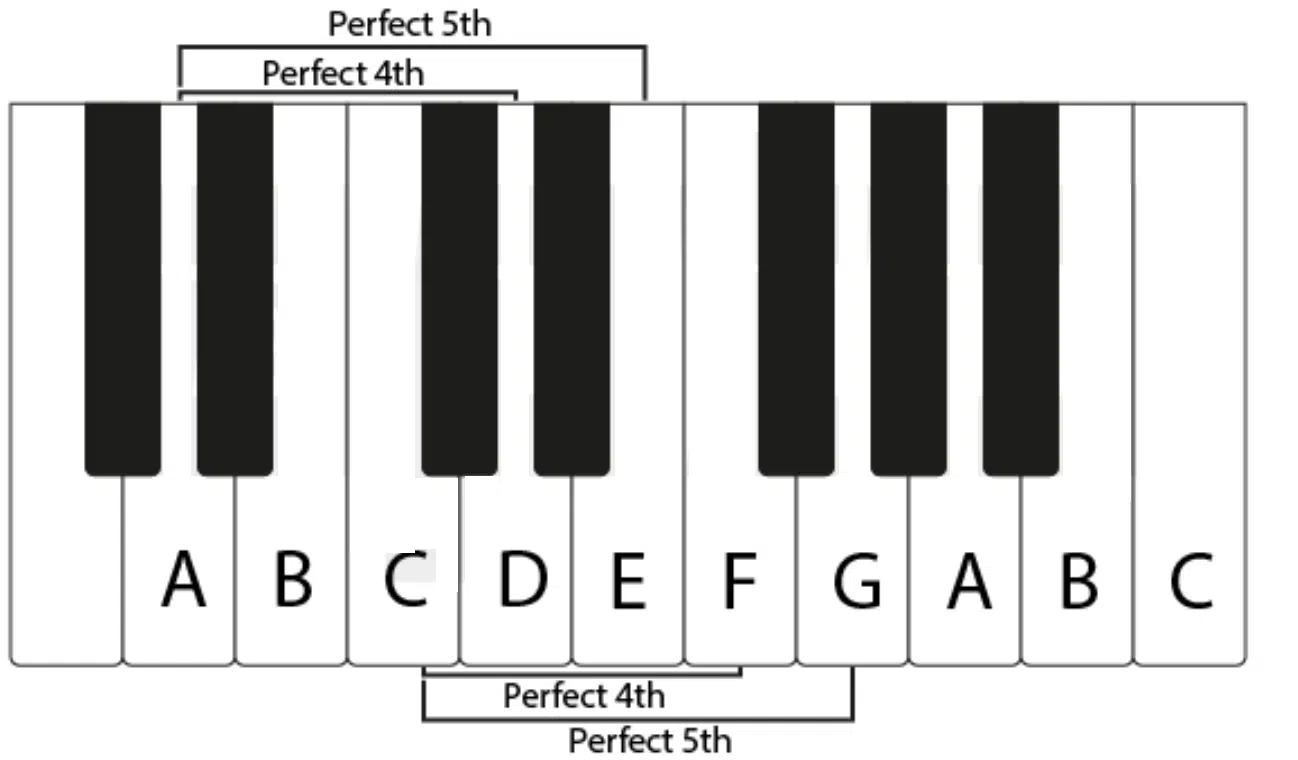
Perfect intervals are unique because they sound harmonious and stable regardless of the musical context (crazy, right?).
Perfect intervals include the:
- Perfect fourth
- Perfect fifth
- Perfect octave
Basically, perfect intervals are where the two pitches have a special relationship based on their positions within a scale.
For example, in any major scale, the perfect fifth is found by counting up five scale degrees from the first note…
This results in the consonant and pleasing sound we were just talking about.
Perfect intervals are truly the building blocks of composition and arrangement, and of course music theory itself.
The perfect fifth, from the first note of a scale to the fifth, reinforces the tonality of a track by locking down the root or base note through its resonance with the upper note.
NOTE: This same number concept of maintaining a fixed intervallic distance will give you a solid foundation. Meaning, a perfect interval is invaluable in both melodic lines and chord progressions.
-
Pro Tip

A diminished fifth is often referred to as the “tritone,” and is one of the most dissonant sounds in music, period.
This interval, lying halfway between a perfect fourth and a perfect fifth, adds some serious tension to any song.
Diminished intervals, like the diminished fifth, are key for creating a sense of unease or drama 一 enhancing its emotional depth even more.
So, if you’re craving some complex harmonic textures, make sure to play around with these intriguing intervals..
Major Intervals and Minor Intervals

Major and minor intervals can both help add some power, depth, and contrast, just in very different ways (which you’ll need to know to know what are intervals in music).
Major intervals, characterized by their bright and happy sound, include the major second, third, sixth, and major seventh.
For example, in the key of C major scale, one of the most commonly used scales, the interval from C to E (a major third) makes the vibe very cheerful and uplifting.
On the same note, the interval from C to A (a major sixth) can transform melodies with a sense of openness and resolution.
It’s used to convey feelings of hope and joy, of course.
Minor intervals, on the other hand, offer a darker, more reflective quality to music 一 including the minor second, third, sixth, and minor seventh.
In the C major scale context, shifting from E to Eb turns the major third into a minor third, dramatically altering the emotional tone to convey sadness.
And, in a lot of cases, a certain nostalgia people are drawn to.
NOTE: This minor third, as well as the music interval from A to F (a minor sixth), is particularly effective in creating a melancholic/introspective mood, so they’re ideal for bring a sadder, Billie Eilish-type vibe.
-
Major and Minor Thirds
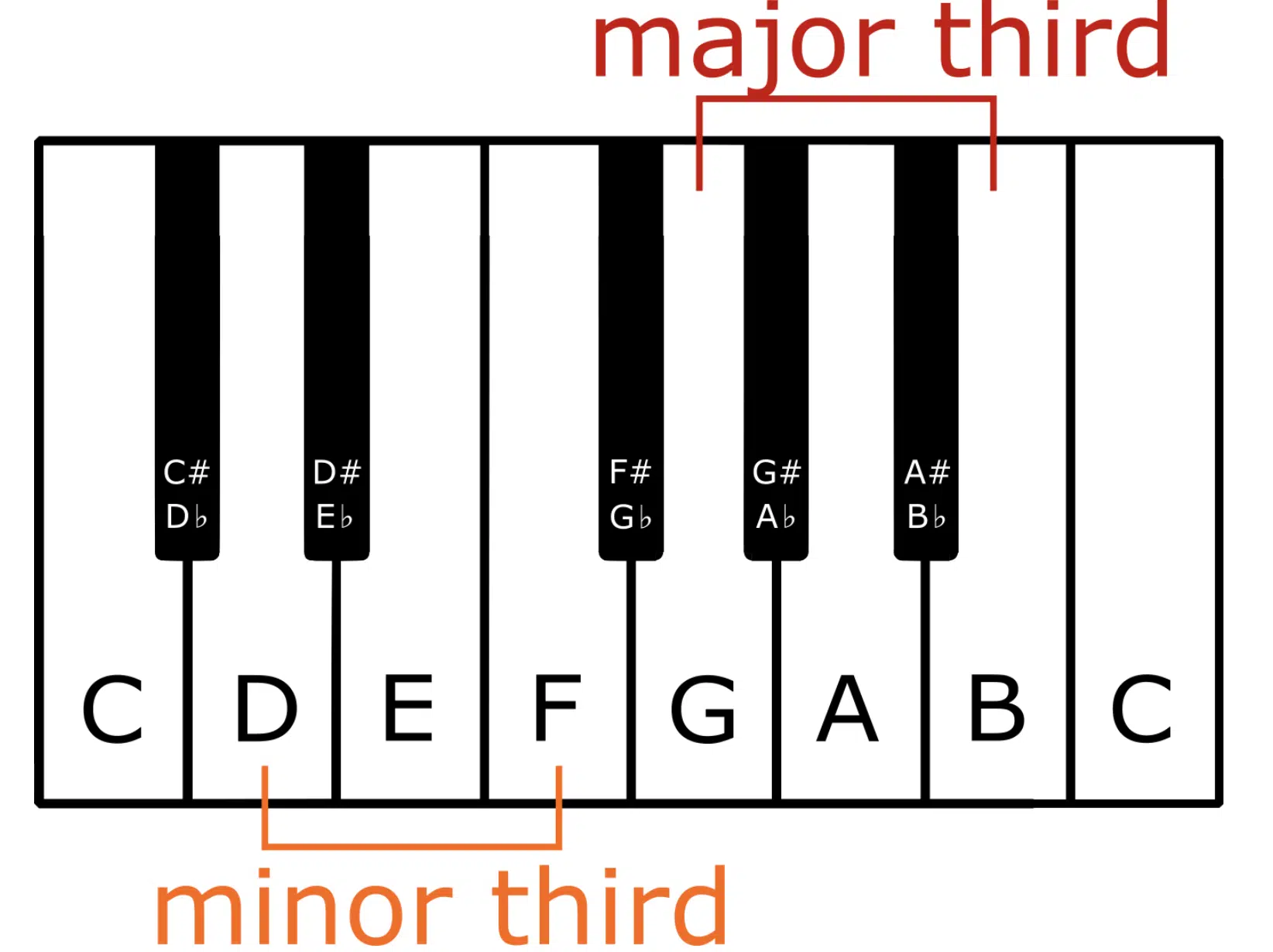
Major and minor thirds are everything when it comes to tonality.
The major third, such as the interval from C to E, imparts a bright, happy quality to chords and melodies.
It’s widely used in upbeat genres like pop to create an inviting and warm sound.
The minor third, from C to Eb, has a sadder, more somber tone, often heard in blues and ballads to really tug at peoples’ heartstrings.
These thirds are not just theoretical 一 you can take advantage of them as a producer of any genre, really (if you get creative enough).
For example, altering a major third to a minor third in a chord progression can dramatically change the mood of a track to pack some punch.
-
Major Sixths and Minor Sevenths
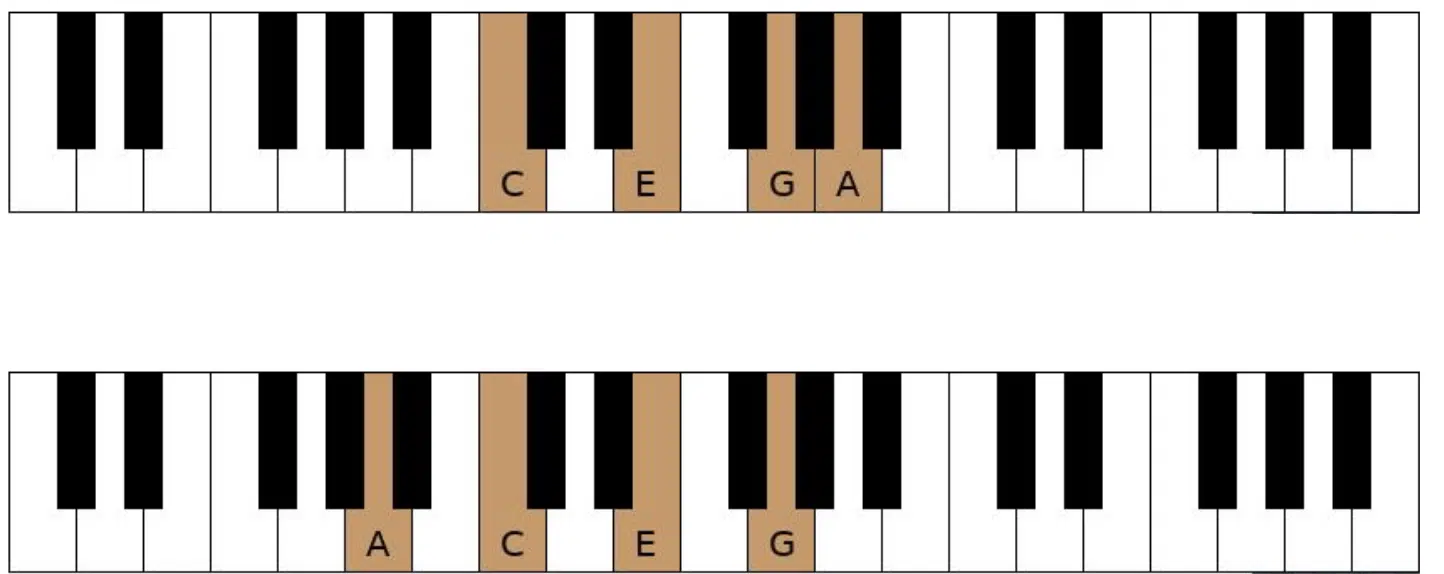
Top: C major sixth chord. Bottom: A minor seventh chord.
If we’re talking emotional expression, then the major sixth and minor seventh are two key players.
The major sixth, like C to A, adds a sense of completeness and resolution, ideal for tracks that require a satisfying, conclusive feel.
The major sixth is great for any genre where emotional depth and complexity are paramount, it doesn’t have to be anything fancy.
The minor seventh, such as C to Bb, introduces a touch of dissonance and tension 一 perfect for creating suspense or unease in a track.
You’ll hear the minor seventh musical interval a lot in genres like funk and jazz.
This is because it’s often used to add flavor to a dominant seventh chord, enhancing the overall harmonic texture and appeal.
-
Perfect Fifth and Fourth (Extended)
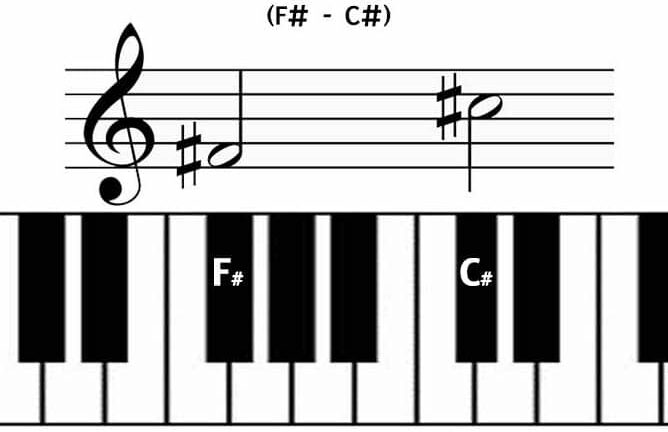
Yes, we briefly talked about perfect fourths and fifths, but let’s just summarize because they’re going to be very important as you advance.
The perfect fifth, such as C to G, and the perfect fourth, like C to F, are among the most stable and consonant intervals in music, foundational to many musical cultures.
The perfect fifth is known for its powerful, reinforcing quality, often used to build chords that have a strong, definitive presence in a mix.
The perfect fourth brings a slightly more subdued tone but is equally essential for constructing solid, coherent tracks.
Using these music intervals in production, you might layer a bassline in perfect fourths to hold down a track’s harmonic structure.
Or, use fifths to support the melody line to ensure each lower note resonates clearly.
Just remember that these intervals are staples in everything from classical orchestration to modern electronic music production.
-
Compound Intervals

Compound intervals, such as the ninth (an octave plus a second), brings a more rich sound to the table.
A compound interval extends beyond the octave 一 offering more complex and colorful sounds that can add depth and intrigue to your tracks.
For instance, using a major ninth in a chord can give it an airy, ethereal quality, which is perfect for ambient music and movies.
Understanding how to use these music intervals allows you to experiment with layering and texturing sounds, creating big/lush movements.
-
Dissonant Intervals vs Consonant Intervals
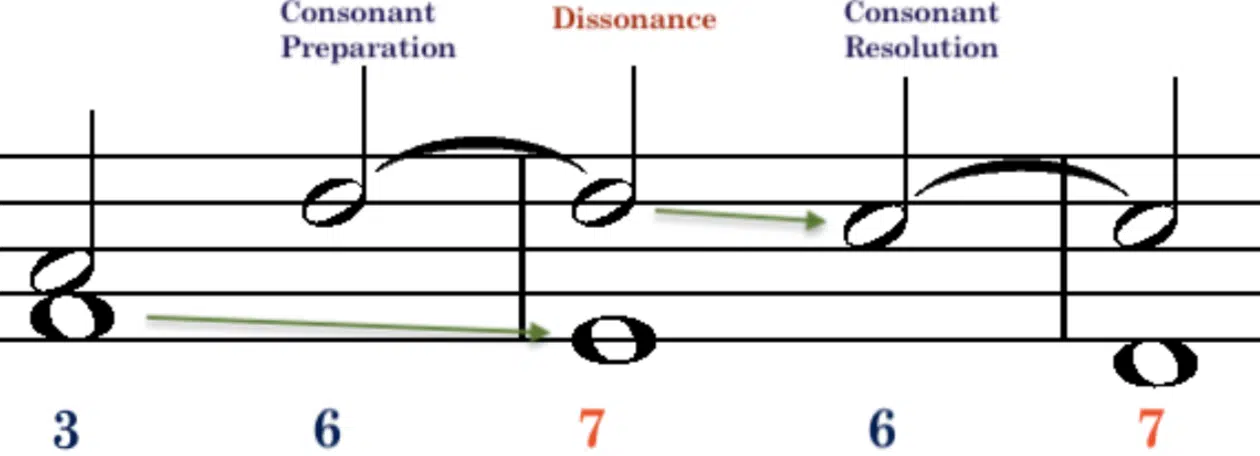
When you’re trying to understand what are intervals in music, you’ll hear the terms dissonant intervals and consonant intervals a lot…
Dissonant intervals, like the minor second or the tritone, create tension and unrest 一 essential building blocks for suspense or climax.
A dissonant interval challenges the listener’s ear, but in an intriguing way, which makes super popular in experimental music.
Consonant intervals, such as the major third or perfect fifth, provide relief and harmony.
So, when you think of a consonant interval, just associate it when a sense of order and cohesiveness.
Balancing these musical intervals in your track can enhance its emotional impact, guiding the listener through a dynamic tension-resolution situation.
This technique is especially powerful in film scoring, where emotional manipulation is center to the overall narrative.
-
Techniques to Help with Naming Intervals

Naming the different interval types right off the bat is key for music producers, especially those first learning what are intervals in music.
So, techniques like ear training, where you practice recognizing music intervals by their sound alone, can greatly enhance your ability to work like an expert.
Using tools like music interval training apps or practicing with a piano can accelerate this learning process.
Another way to make the process easier is to associate intervals with familiar songs or motifs that you love, which can serve as mnemonic devices.
For example, associating the perfect fifth with the opening of “Star Wars” or the minor second with the “Jaws” theme makes these intervals easier to recognize in practice.
By getting it down, you can quickly and accurately identify intervals during production sessions, making you more efficient.
Bonus: Music Theory Essentials
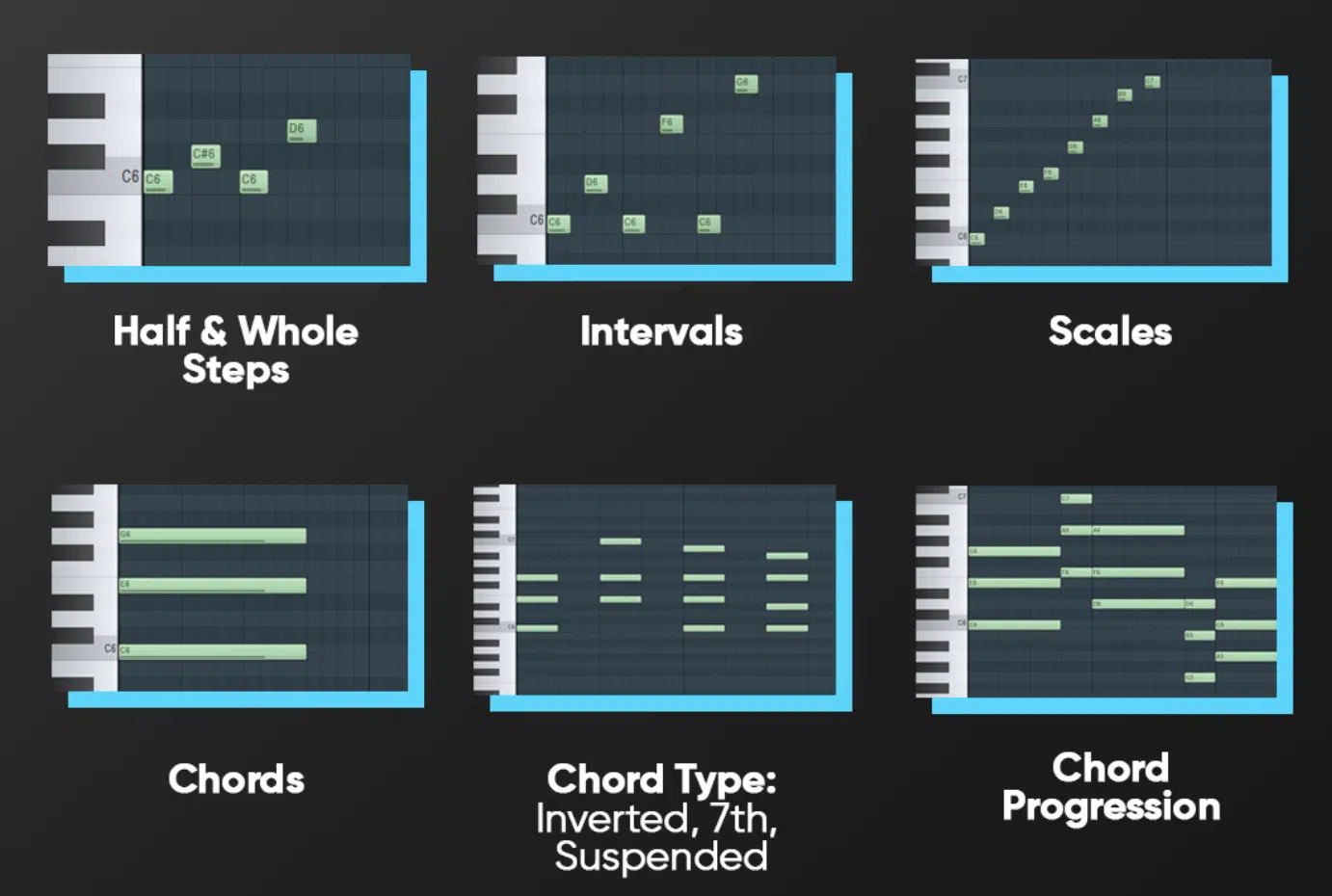
Understanding the role of half-steps and whole steps (semitones and tones) is key for mastering music intervals.
Half steps are the smallest interval in Western music, like in the C major scale: root note C to C# or from E to F.
These basic building blocks help define the structure of scales and chords.
For instance, the difference between a major and minor interval often comes down to just one half-step… a minor third is one half-step smaller than a major third.
Similarly, an augmented interval is created by adding a half-step to a perfect or major interval 一 while a diminished interval comes from subtracting a half-step.
Also, diatonic scales, which are built from specific sequences of whole steps (two half-steps) and half-steps, are essential for any producer.
For example, the natural minor scale features a sequence where half-steps occur between:
- The second and third degrees
- The fifth and sixth degrees
Recognizing these patterns not only helps you when you’re dealing with scale and chord construction, but will help you modulate between different keys.
It will add an additional (dynamic) layer to your track.
Music theory essentials like this can help you create music that really sticks in your listeners’ heads and streamlines your production process.
What are Intervals in Music: Final Thoughts
Intervals in music, as you now know, can shape the entire tonal and emotional vibe of your music.
They can help you construct harmonies that leave a lasting impression and melodies that stick in people’s heads long after the song ends.
Plus, understanding intervals makes your tracks more dynamic and expressive 一 allowing for endless creativity and innovation.
Depending on which intervals you choose to emphasize, of course.
To further enhance your skills and help you answer the question, ‘what are intervals in music?’ you’ve got to check out the free Advanced Scales MIDI Essentials pack.
It includes 24 MIDI scales, melodies, and chord progressions (invaluable!).
These sounds require the highest level of music theory experience to create, and when you use them, it’ll make your music stand out and appear more professional.
Plus, you’ll have a competitive edge over all the other producers who don’t have a music theory degree and better understand what are intervals in music.
Now that you have a solid understanding of intervals and their power, you can go create tracks that not only captivate, but seriously impress.
Unless next time…







Leave a Reply
You must belogged in to post a comment.